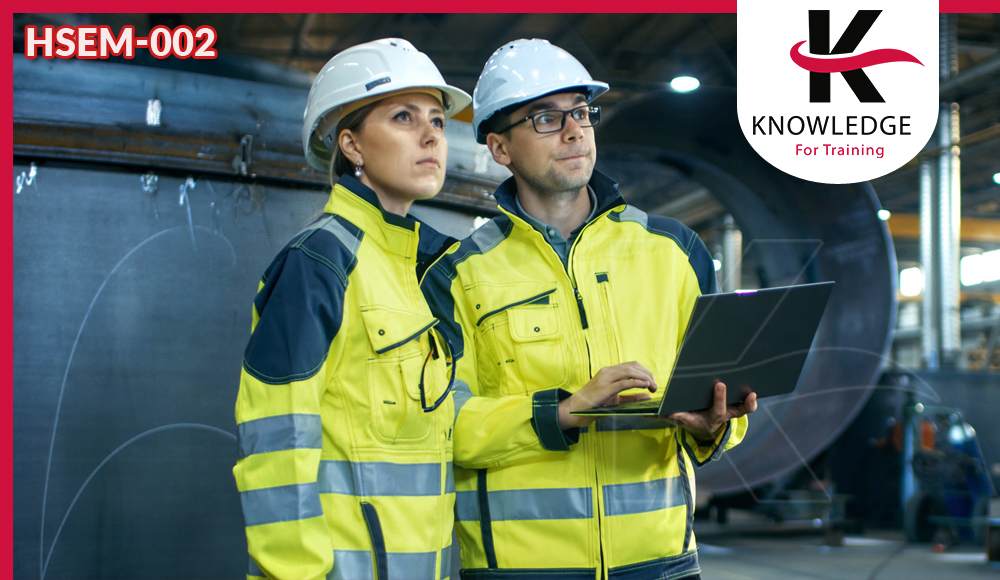-
Course Code
IOSH-002

Certified IOSH Managing Safely
- Give managers and supervisors the knowledge and skills they need to manage health and safety within their teams. Upon successful completion of the course and assessment, students are awarded a Managing Safely certificate from IOSH – the world’s largest health and safety membership organization.
Learning Outcomes
- Apply basic management principles and practices to safety and health issues as part of a total management strategy;
- Set practicable safety and health objectives and plan and implement courses of action to achieve them;
- Recognize safety and health hazards present in the workplace and the types of control measures needed to manage them;
- Take account of risks from work activities arising from human factors;
- Ensure that adequate information, training and supervision is provided for employees in the organization;
- Investigate an incident in order to determine the causes and take appropriate remedial action;
- Communicate effectively on safety and health issues with superiors, the workers they are responsible for and safety and health professionals;
- Have a basic knowledge of health and safety legislation and understand the main legal responsibilities of employers and managers and act to fulfill them.
Course Contents
- Why is it important to manage safely?
- What are your responsibilities as a manger?
- Why is it important to manage safely?
- What are your responsibilities as a manger?
- What is Risk?
- What is a Risk Assessment?
- How are risk assessments carried out?
- The risk assessment game & discussions
- How do you reduce risks?
- How do you decide which risk control to use?
- How do you reduce risks?
- How do you decide which risk control to use?
- What does the law require you to do?
- How does the law work?
- What are the key parts of OHS Management System?
- The law Game
- What are common hazards?
- What can you do about common hazards?
- What are common hazards?
- What can you do about common hazards?
- Why investigate accidents & incidents?
- How do accidents & incidents happen?
- How do accidents & incidents happen?
- How do you carry out an investigation?
- Video / Discussion
- What's performance measurement about?
- How do you measure OHS performance?
- What is auditing?
- What is the Impact of industry on the environment?
- How can you control pollution & waste?
- What are the main elements of an environmental management system?
Day 1:
Introducing Managing Safely:
Introducing Managing Safely – Cont'd:
Assessing Risks:
Video & Discussion
Day 2:
Review of the previous day
Assessing Risks – Cont'd:
Controlling Risks:
Controlling Risks – Cont'd:
Understanding your responsibilities:
Day 3:
Understanding your responsibilities – Cont'd:
Identifying Hazards:
Identifying Hazards:
Day 4:
Investigating Accidents & Incidents:
Investigating Accidents & Incidents – Cont'd:
Investigating Accidents & Incidents – Cont'd:
Measuring Performance:
Day 5:
Measuring Performance – Cont'd:
Protecting our Environment:
Protecting our Environment – Cont'd:
Examination
Our Methodology
- Make coaching and monitoring innovative and using modern
- Media training also using on the go training by using interactive means and focusing on
- The exercises, practical applications and real situations study
- Live delivery method, instructor-led training
- Experienced consultant, trainers, and professional
- Qualified trainer with high-level experience
Attendance Reports
- Send daily attendance reports to training departments
- Send full attendance report to training dep. by the end of the course
- Attend 100 % from the course days also provide daily
- Issue attendance certificate for participant who attend minimum 80% from the course duration
Pre/Post Reports
- Pre- assessment before starting training
- Post assessment after finish training
- Full report for the deferent between Pre-& Post assessment
Who Should Attend
- OHS Managers, supervisors and officers
- Location managers
- Occupational Health Doctors and Nurses
- Industrial Hygienists
- Occupational Safety Engineers
- Environmental Engineers
